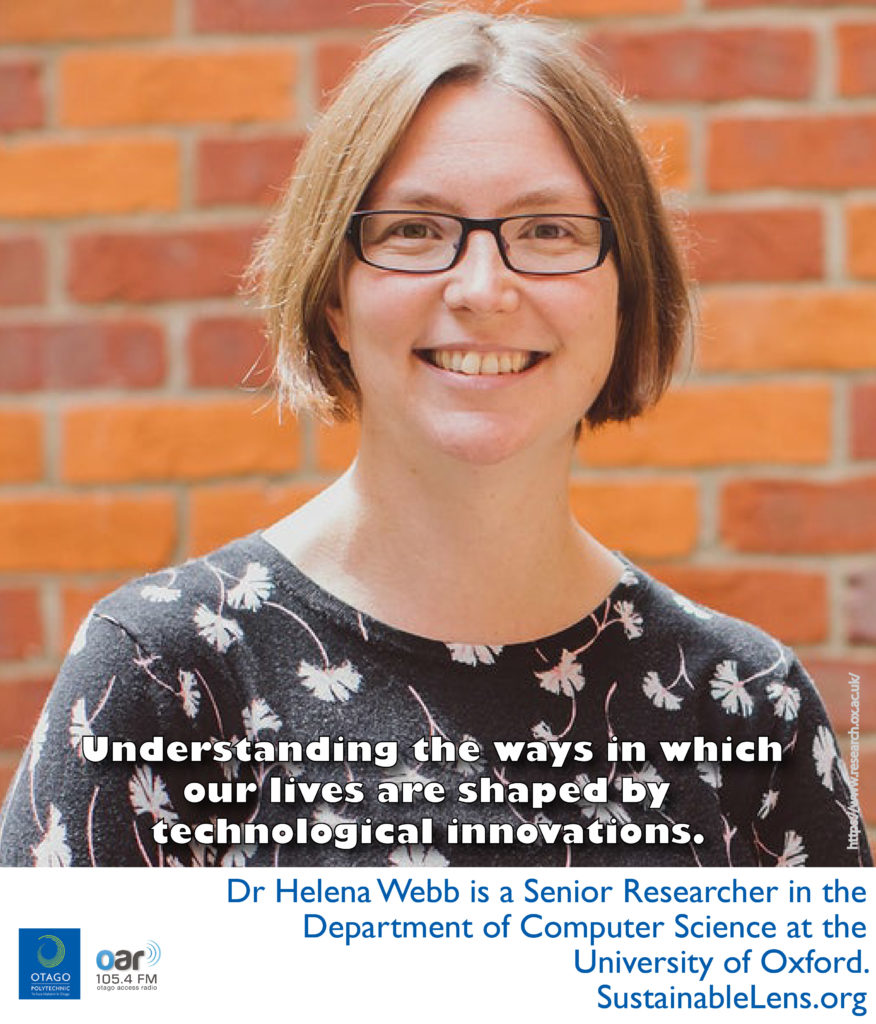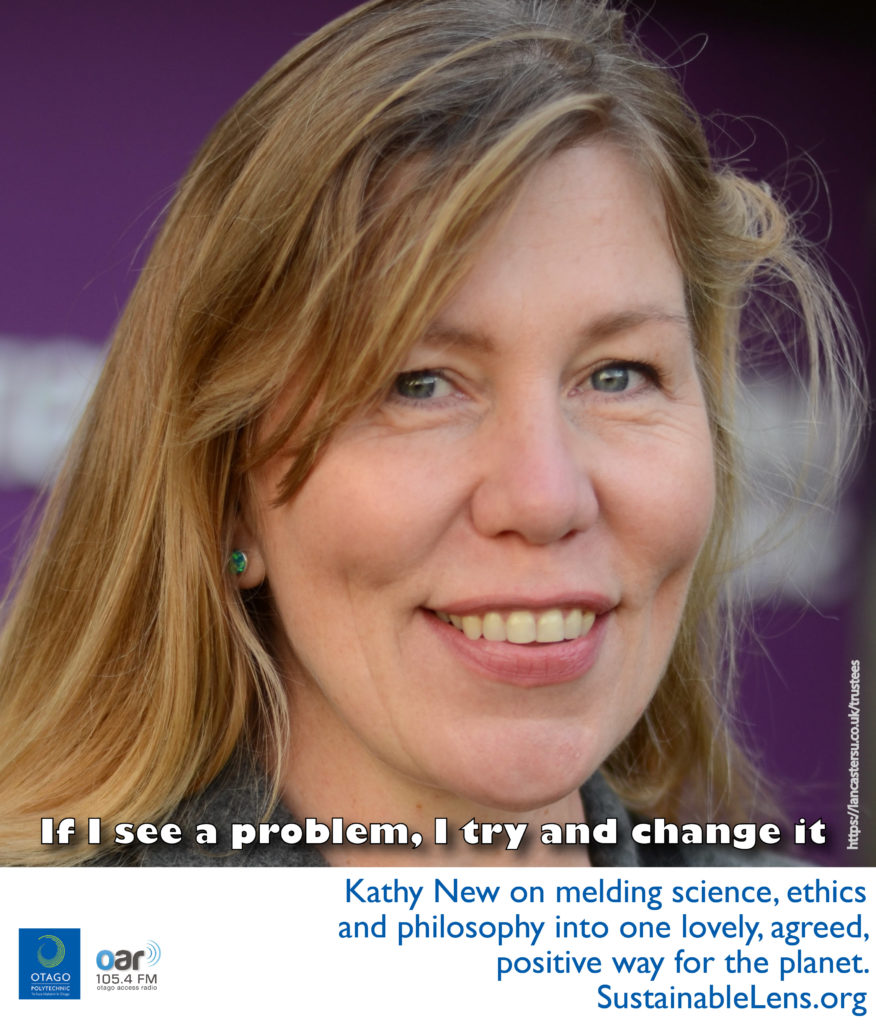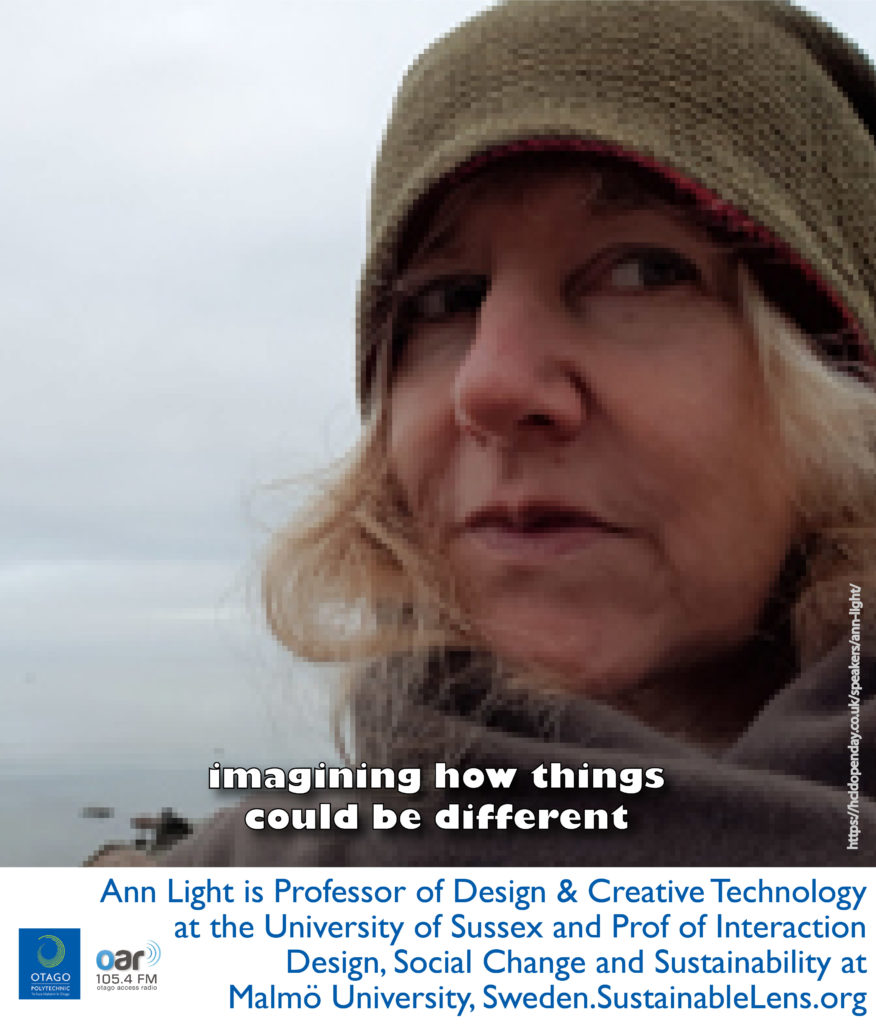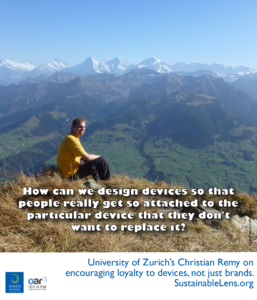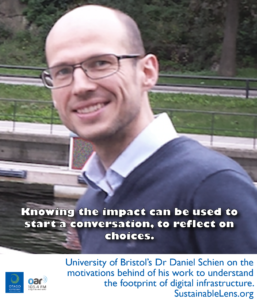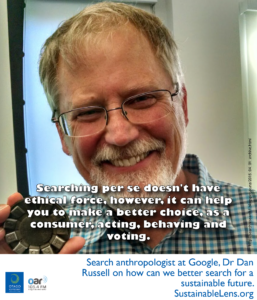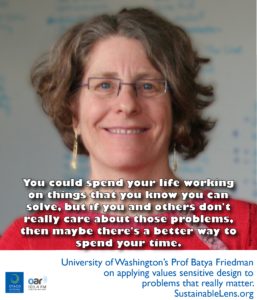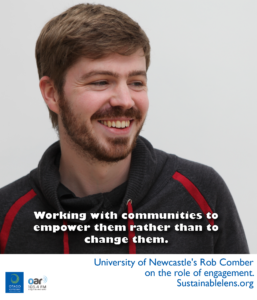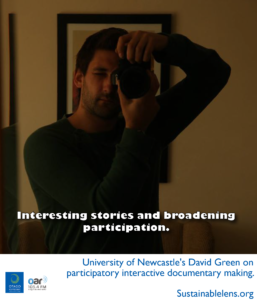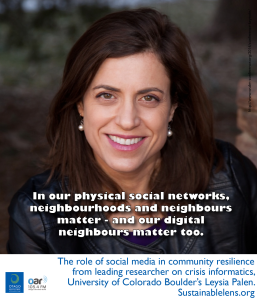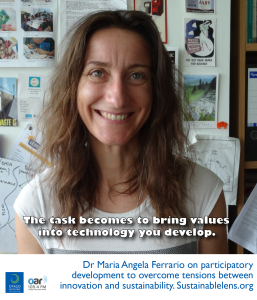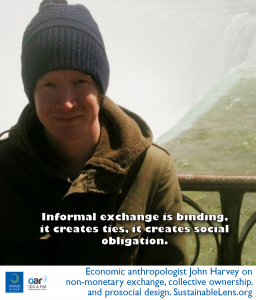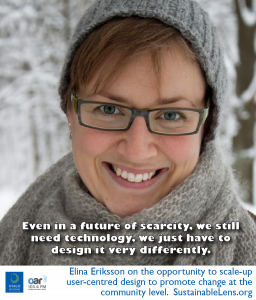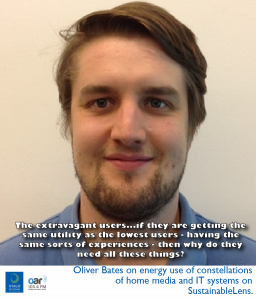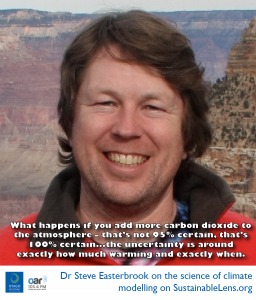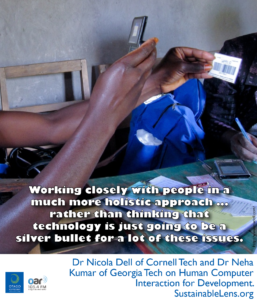
Working closely with people in a much more holistic approach to understanding this domain rather than thinking that technology is just going to be a silver bullet for a lot of these issues.
Dr Nicola Dell of Cornell Tech and Dr Neha Kumar of Georgia Tech join us to talk Human Computer Interaction for Development.
Sam: Welcome to Sustainable Lens – Resilience on Radio, a weekly show on sustainability topics brought to you by Otago Polytechnic. The show is co-hosted by Shane Gallagher who is not here tonight and me, Samuel Mann. Each week we talk with someone making a positive difference and we try to find out what motivates them and what it means to see the world through a sustainable perspective, through their sustainable lens.
Tonight we have two Sustainable Lenses, that of Nicki Dell from Cornell Tech and Neha Kumar from Georgia Tech. They both work in the area of Human-Computer Interaction for Development, both developing technologies for underserved populations, marginal populations and so on. Thank you for joining me.
Nicki: Thank you for having us.
Sam: We’ll start with Nicki then, shall we? Where did you grow up?
Nicki: I grew up in Zimbabwe actually, Harare, the capital city of Zimbabwe, that’s where I was born and that’s where I still call home.
Sam: What did you want to be when you grow up?
Nicki: That’s an interesting question. Most of my family is in the health area. My parents are pharmacists, my grandfather is a doctor and so I kind of defined my goals by not wanting to be in health and ended up choosing computer science because it was about as different from going into a medical profession as I could find at the time in Zimbabwe.
Sam: What did you think was going to happen if you did computer science?
Nicki: I wasn’t too sure. I think I didn’t really know what it was. It just sounded cool at the time. Once I started doing some programming courses, there weren’t very many at my school. It was kind of a small community. I decided that this was something that I liked a lot and I liked using code to build things that were useful to people, but I didn’t really have any idea that I would end up where I am today.
Sam: You did always think useful to people or is that something that you think you might be looking back on and thinking that’s what the goal was?
Nicki: Remember that the very first project that I ever worked on when I was fourteen working in a very old programming language called COBOL, that is from the ’70s, I was building a system for tracking pharmaceutical drugs to try and identify if people would take two drugs that had an interaction, whether or not they would end up combining. There was definitely from the beginning an interest in building systems that actually did something and that helped people.
Sam: That sounds suspiciously like a health front.
Nicki: I know. Well, I failed in my mission as you can probably tell almost immediately. That was the motivation was to not get a degree or to do anything academically related to health, but turns out that over the years I’ve progressed probably more and more towards doing projects that at least touch on the health domain in some way, so I guess I’m a failure.
Sam: And Neha?
Neha: Hi.
Sam: Where did you grow up?
Neha: I grew up in New Delhi. That’s where I was born and brought up. That is also where I still call home.
Sam: What did you want to be when you grow up?
Neha: I can’t really remember what I wanted to be. I think I just wanted to do math and that’s what I wanted to do in high school. When I went to college, it’s what I wanted to do. Of course my sister had done economics, and so I thought I could do math and economics and be exactly like her but then I ended up taking a different track.
My Mom was insistent that I take computer science or at least try it out. In my first semester as an undergrad I remember thinking that I’m just going to take this course so that I can finally just tell her that I don’t like it and that will be the end of it. Otherwise she’s always going to be telling me to take this course. Then I took it and I loved it, so that’s how I ended up doing computer science but I also did math.
Sam: Why did she want you to do that?
Neha: She thought it was really exciting. She thought, for whatever reason, that I would be good at it. I’m sure she thought that it was the thing to do because that’s what a lot of Indian parents think. She also felt like she would have loved to do it and she didn’t really have that chance, so she wanted me to try it out.
Sam: Where did you do your degree?
Neha: At Berkeley.
Sam: Straight on to?
Neha: I went on to do my master’s in computer science. That was at Stanford and then I went and worked at Microsoft for a couple of years. I was working on the PowerPoint team. At that point I was really excited because I was working on a product that I thought everyone knew and used and found useful, but it quickly got boring.
Very soon after, I was really kind of dying to get out. I thought I had my mid-life crisis. It was probably a quarter-life crisis but I just felt extremely unhappy, as I put it then, working on technology for technology’s sake.
The other thing was that I had always had an interest in education, so I had worked through my undergrad in an education nonprofit and working to support education projects in India. I didn’t know what else to do but thought I would try to use my computing skills somehow in the field of education, and that’s what made me go back to grad school.
Sam: What did you do then or where did you go?
Neha: I went back to Stanford to do my Master’s in Learning, Design and Technology and that was a programme in the School of Education. It was a fairly new programme at that point, but they had put it together to get people to think about how technologies could be useful in the education space. That was a one-year programme.
While I was doing that, I had the chance to do fieldwork for the very first time. I was in rural Karnataka in India helping another grad student in Berkeley with his PhD research. That experience is still my most favourite field experience, and will be I’m sure.
Sam: When you described it as Learning, Design and Technology, I was imagining it was going to be about designing, modelling things for use at places like U.S. institutions, but they had a much wider use in that?
Neha: No, they didn’t. Interestingly, I knew someone in that programme and she was developing a curriculum for teaching youth about HIV and how they could be more aware. I thought that that was incredible that there was a programme that would allow people to do that kind of work in their master’s research. I got involved with that project only because she needed someone who could speak with an Indian accent.
I was just doing voiceover, but when I found out more about her project I thought that was really cool and I need to apply to this programme and I need to do this thing. When I started the programme, I realized that I was the only one who had an interest in doing anything outside of the U.S. but I tried to do that anyway. That’s also when I applied to do my PhD to work with Tapan Parikh at the Berkeley School of Information. He had been doing work in this space for a long time.
Sam: What did you end up doing a PhD on?
Neha: My PhD was actually in ethnography. I was studying youth from marginalized communities in rural, semi-urban, and urban India and trying to understand what drives the adoption of technology in those contexts. My goal was to actually do a situated ethnography, understand how people were driven or why people were driven to using these technologies, and how technology could be designed in ways that actually resonated based on the uses of technology by these people. That’s how I ended up doing my PhD research and trying to understand how these youth were appropriating mobile technologies.
Sam: What’s the short version of the summary of the findings?
Neha: The findings, well what I found was that entertainment was of course the driving force. I studied how music was a motivator and how music and videos and soon the social networking were really driving adoption of these mobile technologies. What I studied and what I wrote about in my dissertation was really how these youth were a little driven by leisure and entertainment and ended up creating these informal learning environments for themselves and how these entertainment-driven uses were actually leading to development oriented outcomes.
Sam: Back to Nicki. Where did you do your undergrad education?
Nicki: I did my undergrad degree in the UK at a university called the University of East Anglia which is in Norwich. I did a year of it abroad from there in Canada at the University of Victoria in Vancouver Island.
Sam: You did?
Nicki: My degree was in computer science and most of the work that I did as an undergrad actually focused on computer graphics, which at the time I was very taken with. When I graduated I actually moved from England back to Africa to South Africa and lived for two years in Cape Town, working in an animation studio there mostly designing and creating digital content for kids. The animation studio has since put out several feature-length films that I think are Africa’s first feature-length animation, CG animation films.
Sam: Cool. That sounds fun. Why did you leave that?
Nicki: The entertainment industry ended up being not all that I thought it was going to be. I found that very quickly I also got a little bit bored with the actual day to day of the work that I was doing. In addition, it seemed to be a little bit more focused on designing characters that would sell and franchises and those sorts of things rather on kind of learning content or fun content for kids. I think I lost a little bit of the … The stars in my eyes were put out a little bit by that.
Maybe as Neha said, it was more boredom and the desire to go and see the world a little bit more and do some travelling. I quit my job in Cape Town and then I moved actually to South Korea and worked as an elementary school teacher for two years in South Korea teaching math, science, and English to elementary school children in an English immersion program in South Korea.
Sam: I wouldn’t have predicted you were going to say you went from Cape Town to South Korea.
Neha: Yeah.
Nicki: That’s why this is an interesting story. I mean, it was an incredibly valuable experience. In a lot of ways, it allowed me to travel extensively around Asia and Southeast Asia and to experience a lot of contexts that were different to Africa in a lot of ways, but also similar in many ways.
I also discovered that I did like teaching. Now having ended up as a professor, I think that was key in learning that being in a classroom and having kids learn or having students learn is something that I really enjoy. It definitely influenced my future career trajectory.
Sam: After that?
Nicki: After that I decided to conform to the rest of my life and applied to do my PhD in America. Interestingly, I was mostly motivated by not having lived in the States yet, so applying for grad school in the States was partly an excuse to go and live there for a while. My top choice of places to do my PhD by far was the University of Washington. They have a fantastic Computer Science department and were really very supportive from the very first email that I ever sent the administrator there. When I was accepted there, it was kind of clearly my top choice of place to go.
Sam: Did you know what you wanted to do?
Nicki: I did not. I started out thinking that I wanted to do more image processing and computer vision, which is when computers are essentially being able to see and interpret things in the world as we do. Although in my first year of the PhD I met my advisor, Gaetano Borriello, and he was working in this space. Initially I was incredibly skeptical.
I went to some of his seminars and I sat through some of the talks and I kind of thought this stuff is never going to work. The challenges are too great. The people are not going to be interested in this. Everything is going to break. It’s dusty. It’s dirty. Why are we even trying? This is all a waste of time. Then perhaps like Neha, so Gaetano kept at me for a while and I eventually started to come around and then I went and did some fieldwork myself.
I think as with her experience being in the field and actually seeing people and talking to them and interacting with them fundamentally changed the way that I thought about this particular part of computer science. Seeing their eagerness to embrace new technologies and to do things that everyone else was already doing, but more than that to do it for their own purposes and have the same opportunities that are enabled by digital devices and information really motivated me to stick with this particular area and continue to do work.
My PhD work ended up focusing on trying to see what we could do with the camera that comes built in to commercially available smartphones. If we can take images and videos using the camera, process them on the device to solve problems in data collection. Collecting data from communities and in settings where most data collection is still done on paper forms and to improve disease diagnosis by analyzing diagnostic tests for diseases like HIV and malaria.
Sam: This was about enabling communities to digitize their land records or…?
Nicki: Yeah. I really worked on two systems. One was digitizing data from paper forms. The basic idea is that you take a picture of a piece of paper using the camera on the device and it will register that image and automatically extract the information from that picture and put it into a database that can be queried and searched and analyzed in ways that paper can’t be, but continue to let people at the field level to use paper because they’re familiar with it. It’s cheap.
There’s a variety of different reasons why people like paper even in U.S. contexts, so universities. It’s everywhere. We wanted to allow them to keep using paper but at the same time digitize the data so that it could be useful for more decision making and higher level analysis that it currently wasn’t being used for.
Sam: My experience of paper-based forms outside the western world is that they’re incredibly intricate and really complicated things.
Nicki: Yes, absolutely and we saw that a lot. A lot of the forms that we ended up looking at, so we specifically focused on nongovernmental organizations or ministry forms and overwhelmingly there’s a huge push to convert all of the data into structured data. Most of it was looking at, for example, filling bubbles or check boxes or numbers rather than having fieldworkers write long passages of text. Developing algorithms and machine learning systems to interpret that structured data was a much more tractable problem and something we could find solutions for, using the computation power available on a mobile device.
Sam: Your field site for this was in Africa?
Nicki: The work that I did for this was based primarily in Mozambique. I was there, I did two deployments in Mozambique and we actually have another deployment that’s still going on in Malawi.
Sam: You had the advantage of coming from Africa, but you still had that experience of going backwards and forwards from a lab writing code environment to a field environment.
Nicki: Yes.
Sam: I’m not sure if “were you prepared for that is?” the right question, but is it hard?
Nicki: Absolutely. It was definitely very challenging. I think the first thing you learn immediately as you take something, a new system or a new device out into the field is that every assumption that you made was probably wrong. There’s a lot of you go back to your hotel room in the evening and redo everything hurriedly and hopefully in time for the next morning and the next day’s fieldwork.
There’s a lot of things that go wrong. I think something that always strikes me though is people’s willingness to put up with imperfection. From my perspective, I wanted the system to be perfect. I wanted everybody to be able to use it and have it never fail, never have any data collection issues or server issues or never lose internet connectivity. In reality, these things happen very frequently and people’s patience and willingness to persevere even when those things happen or the imperfection of the system is making it difficult for them to do their job is something that always struck me.
Sam: The second project you did was on diagnosis?
Nicki: The second project I did was similar. The first project was taking pictures of paper forms and extracting data. The second one was taking pictures of diagnostic tests and automatically interpreting the result of those. You would have a little plastic cartridge and that would have a series of coloured lines that would tell you whether or not somebody, for example, had malaria or HIV or syphilis.
It turned out that a lot of the nurses in the settings where they use these tests make mistakes. They don’t see faint lines, faint positive results. They don’t have a lot of eye care, so a lot of the older nurses, for example, don’t wear glasses when they should and there was a lot of positive tests being missed.
The idea behind having a system take pictures of the tests was that there would be a record of that afterwards. The system could interpret the diagnosis to either confirm the same diagnosis as the nurse or provide an alternate one that would suggest maybe do another test and get another opinion. Taking that data and then transmitting it to a database that was accessible to the Ministry of Health for them to start doing some disease surveillance and outbreak detection and those sorts of higher level decision making.
Sam: Now, the paper that you have presented at this conference is a meta-analysis of a lot of work done in HCI for Development, HCI4D. Before we talk about that, I’m having such a good time listening about your actual projects both of you. Let’s carry on doing that for a bit and then we’ll talk about the work that you came here to talk about.
Nicki: Absolutely.
Sam: Neha, what sort of work have you done since you graduated?
Neha: Since I graduated, I had the chance to be at the University of Washington where I was a postdoc in the same group that Nicki was doing her PhD. Â That’s how we first got to know each other and started to work together. The project that I was doing primarily during my postdoc was actually operationizing my dissertation findings, so trying to see how media practices that I had observed and written about in my dissertation, how those could be leveraged in maternal health contexts in rural India.
There’s a project called Projecting Health, which I’m still working on though remotely that was started at the University of Washington. The goal of that was to use videos that were created by the community for the community and of the community for training or teaching mothers, the new mothers, how to feed, how to take care of their newborn infants. That’s the project that’s been going on now for more than three and a half years in rural UP in India.
Sam: That involves teaching people how to make the videos to start with?
Neha: Yes. In the beginning there’s a workshop of one or two weeks. We’re going to do one again soon, but the project started with that. There were NGOs that we were partnering with in the field. The staff from the NGOs were shown how to create videos using these low-cost cameras and then how to edit these videos, and also the process of storyboarding, so how they could take a health message and turn that into a video that wasn’t purely instructional, but also had like a little bit of a story in it.
They appropriated that process to then create these ten minute, fifteen minute videos which were really kind of short Bollywood films, I would say, of people within the community and trying to get at how … I mean, there were certain topics such as exclusive breastfeeding or institution deliveries or family planning methods. These are films that are kind of revolving around those topics.
The health workers are the ones who are responsible for getting this information, these films out to the communities. The staff of the NGO is responsible for creating these videos and for auditioning people, so bringing them into the cast of these videos and such.
Sam: Has it worked?
Neha: Has it worked?
Sam: How do you tell?
Neha: Well yeah, how do you tell? That’s a great question. I think that’s a really important question to ask for any project in this field. I think that the key point here is that we’ve been partnering with PATH, which is a global health organization. They have been responsible for doing the baseline, the end-line surveys to kind of see how the project has been progressing, what are the issues from the health and behaviour change standpoint.
The folks at the University of Washington and me have been looking at the technology side of things, so how could we leverage existing technology practices. For instance, how people are using mobile phones to either create or watch these videos and how those practices could be brought into this system so that the community can then both consume and share this content with others.
Sam: For this conference, the first keynote Dayo Olopade talked about development in Africa. She talked a lot about the informality and so on of the work and those different things. The first question someone stood up and asked a question along the lines of, why should San Francisco care or how is this going to make money for San Francisco? It seemed to me that he’d not listened to the whole talk. Are people talking at totally cross-purposes?
Neha: Are people talking at …?
Sam: At cross-purposes, are people like not listening at all? How far away from San Francisco development is development for Africa and India and so on?
Nicki: Hopefully it’s something that is getting better particularly within this HCI community and at the conference that we’re at. We’re starting to see that by having keynote speakers like Dayo come and give the keynote, one of the great things about a talk like that is that it starts to sensitize more of the people that are focused primarily on results, which settings or the Silicon Valley setting and allows them to think more about the kinds of problems that happen in other parts of the world.
I think it’s starting to happen more and more and bridging those divides. Our paper, for example, is similarly trying to offer a perspective to the larger HCI community and say here are some of the findings. Here are some of the lessons that we’ve learned and that can inform the broader field so that we can start to have more cross-pollination of ideas.
Neha: One thing in particular that I would say that she talked about, which I think is really critical even for people in our community to kind of listen to and think about, is the agency of the people themselves. It’s not just that we are developing these technologies to help people. I think if we get into that job then there’s no getting out of it.
It’s not that we’re helping people, so to speak, because that kind of also carries with it a very paternalistic sense. I personally think that I’m doing this work for myself and not for anyone else that I’m trying to help, but also I think that that helps in seeing people for who they are and valuing things the way that they value them as opposed to imposing our own value systems and our own judgements on them.
I think that’s something that she talked about with this idea of Kanju, I’m not sure if I’m saying it right, but Kanju, which is similar to Jugaad in India. This idea that people figure out their way based on the limited resources that they have. Certainly we can develop technology-based solutions for them, but we have to be really careful that we’re not also imposing our own value systems on them as we do that.
Sam: You’re listening to Sustainable Lens – Resilience on Radio. I’m talking with Nicki Dell and Neha Kumar about HCI4D, Human-Computer Interaction for Development, of which you’ve just done a big study of hundreds of papers that have been written in this field. Tell me about that study.
Nicki: We wanted to have a moment in time in which we pull together the field and kind of take stock of the ground that we’ve covered so far as well as analyzing some of the challenges that lie ahead and how we can move forward as a community. I don’t think anyone has done a kind of synthesis like this for a number of years now, and so it kind of was a good time to do it. The theme of the CHI Conference this year being CHI For Good, it also felt like a good moment in time to do this particular work. I’ll let Neha talk about some of the details.
Neha: Well, I think that just the process of putting together repository of papers was really challenging. Initially it was just hard to figure out like where do we look to find these papers? We tried to do it in as a methodologically rigorous a way as possible to try to target a good number of scholars and asking them where to look for these papers, what work to look at.
Then we went through the process of actually looking through all of these hundreds of papers, brought the list down to two fifty-nine somehow. It would have been nice to have a round number but we settled on two fifty-nine and then did the work of actually going through all of those papers.
Both Nicki and I went through them separately then went through them together, try to come up with a table of which we’re hoping to then share with the community and we’re hoping also that it will be useful for them. This table basically captures what the paper is trying to achieve in terms of who it targets and where the work has been done, why or what purpose such as education or healthcare or internet access and such.
Sam: We don’t have the paper in front of us, but I’m sure you can remember the generalities. Where was most of the work? Where were people focusing?
Neha: Well, a lot of the work was done in India and I think one of the big reasons for that is that there’s a Microsoft Research Lab in India which has been turning out a bunch of papers ever since it was set up more than ten years ago. Also the fact that English is … You can pretty much get by with speaking in English. The government is friendly to folks doing this kind of work.
For a lot of those reasons, India turned out to be the most popular country. I think there were more than a hundred papers that were looking at work in India. Aside from that, what were the other countries would you say?
Nicki: I think the next two most popular countries were South Africa and Kenya. Perhaps for similar reasons, they’re a little bit more friendly to English-speaking research communities. One of the great challenges I think that were surfacing in some of the deeper analysis that we did was the issue surrounding language and this bias for countries where English is spoken.
For instance, there was a dramatic lack, I would say, of work that had taken place in Central and South America at these particular conferences. The question we got at the end about looking at more local venues if we have been doing an analysis of maybe the venues actually in South America where the content is in Spanish and people are reading it in Spanish, there would be more work there. The point I guess is that that work is being done but it’s not finding its way into our community and our conferences, probably at least in part because of the language barrier.
Sam: What focus areas are people working on?
Nicki: There were three that really stuck out as being the leaders. I think the first one was education which covered both formal education, so interventions or systems that were targeting schools and teachers in schools, as well as more informal education.
For example, by teaching people how to do house work so that they could get a job as a house keeper, teaching people about health practices and other information services. Education was first. I think second was access, which we defined broadly as systems that sought to give people access to computing, access to the internet, access to information through …
Neha: Also papers that were studying access, so how communities were accessing technologies and the internet.
Nicki: Social media platforms like Facebook.
Neha: Yeah.
Nicki: Then the third one was health. There was a lot of work that was looking at community health workers and maternal health and trying to use usually very basic phones to provide information to patients around good health practices. Reminding them to go and do clinic visits and those sorts of interventions.
Neha: I would say that some of these papers do actually fall in a couple of areas. It’s not just that they’re only education, they’re only health, they’re only access. They might span both health and education for instance.
Sam: How do people frame the problem? I don’t want to say that they need a problem for the paper, carefully avoiding saying that a city or town is a problem, but how are people seeing what they’re doing? What’s motivating them, I suppose?
Nicki: Yeah. I think there’s a couple of things. A lot of things have identified very concrete problems. Some of the higher level goals are, for example, set by the Millennium Development Goals or now they’re the Sustainability Development Goals.
Neha: Sustainable Development Goals, yeah.
Nicki: Sustainable Development Goals. One of those would be to reduce by half maternal mortality. You would then say in this particular country, the maternal mortality rate is whatever number and that’s high compared to the world average. We wanted to design something to see if we could reduce maternal mortality in some way.
Neha: It’s very much about identifying resources that you’re looking at that are limited in some way and then trying to make up for those limitations by using technology-based solutions. That’s the interventionist work, but there’s also quite a bit of qualitative, more interpretive work that looks at, in specific contexts, how are people engaging with technologies? How are they using them for education, for finding jobs, for accessing social media sites?
There are those sort of parallel tracks also because the people who are doing this work come from very different backgrounds. There are computer scientists. There are also social scientists. There are cultural anthropologists.
I think that one of the unique things about this community is that there are people from these different disciplines who are able to come together and work together and use different methods, which is not always something that you find in other areas. There’s been a fairly harmonious coexistence I would say.
Nicki: Just to add to that, something that I think our paper at the conference really surfaces quite nicely is that maybe a decade ago a lot of this work was much more technology-driven. It was how can we take technology and put it into these contexts and have it save them and help them?
I think certainly what our work has shown is that we’ve come a long way in recognizing that we need to actually contextualize it. We need to go there and speak to people and understand their realities. Working closely with people in a much more holistic approach to understanding this domain rather than thinking that technology is just going to be a silver bullet for a lot of these issues.
Sam: How do people claim success? Not how you’ve measured their success, but what are they claiming?
Neha: A lot of different ways I suppose, and that also goes back to the disciplines that people are coming from. If they’re in global health, for instance, or they work in education, for instance, then their metrics are a little bit different. Again, they might be looking very much at quantitative measures or they might be looking at more qualitative aspects.
Success is hard to measure over a short period of time. There are some projects that have tried to do that, but they are mostly the projects that have lasted for four or five years or more. There’s not that many of them still in our field and one of the things that we talk about in the paper also is this distinction between outcomes and outputs and what we’re trying to produce immediately with our research and what we’re aspiring to produce in the long-term.
There’s also the difference between just looking at engagement with technology as opposed to actual say learning outcomes in the field of education. There’s lots of different ways that people try to conceptualize these things, but success, there’s no single definition of it. It mostly comes from the disciplines, so HCI or education or health or development. I think it gets harder and harder in that, harder to measure success.
Sam: There’s always going to be a problem with doing academic research in a development type thing when we’re starting to talk about intergenerational equity and things taking tens of years if not longer, and the drive to get on the conference cycle, you’ve got to produce something in six months. The PhDs are lucky if they get to stay in the field for more than a few weeks.
Neha: Yeah.
Sam: Is that unsolvable or do you have any suggestions on how we could address that mismatch of timescales?
Nicki: There’s been a couple of different ways that people have started to do this. Certainly one thing that came up a lot and that Neha pointed out is this idea that we’re aspiring, for example, to reduce maternal mortality. What we can show in the short-term is that reminding people using SMS reminders, for example, will increase the number of times they go to the clinic.
You’re not necessarily showing them the whole outcome, but you’re showing some improvement in metrics that do actually matter. There has been a different way of doing this is that we know certainly of a few people who have then taken their PhD work and created companies or organizations around that so that they can do this in the longer term. I think there’s a large push towards trying to do things in a sustainable way, so having interventions or projects or systems that go on for multiple years.
Figuring out how to support that or how it can be self-sustaining is one of the big challenges that people are grappling with at the moment. Rather than just doing your three years of PhD work and then packing up and everything is over, how do you actually build capacity in these places and put systems in place that don’t require you to manage it and maintain it.
Neha: One of the things that I think has worked well with a couple of the scholars that I know the work of is that when they’ve been in the field, they’ve tried to recruit local students and tried to work with them. What happens then is that when they’re not in the field, the students can still continue working. Certainly having Skype has helped and being able to work remotely or conference remotely.
Those are also some of the things that people have tried. I would say that different programs also have different requirements. Being at the Information School, I was able to actually spend one and a half years, a total of one and a half years in the field before I graduated but that’s not something I think I could have done in several other programs.
Sam: Do you have a favourite study that you looked at, it doesn’t have to be one of yours, that you thought, “They nailed it”? Maybe it’s not an individual study. Maybe it’s a sort of approach or pattern or something.
Nicki: Yeah. We did actually ask about some of the work that the people we were talking to and the people whose opinions we really document in the paper. We asked about work that they considered to be exemplary research and there were a couple of things that really bubbled up to the surface.
One was a body of work that has been looking at how to create systems that enable low literate people or people who might be blind, for example, to engage over voice or through graphical text-free interfaces. I think a lot of the work that’s really focused on providing low literate or illiterate people with access to the same kinds of services and information that people have when they are literate was certainly one of the biggest things that came up when people were thinking about exemplary work in this area.
Neha: Yeah. I would say that in general the type of work that I find really inspiring is when people put in a lot of effort to understand a space using ethnographic methods. Looking at the entire context and not just technology for instance. Looking at the socio-technical contexts and then designing technology interventions that might address that particular population in their context, addressing their needs and so on.
There is some work that’s more recent that I think tries to do that coming from Cornell actually by Ishtiaque Ahmed who has been doing work in Bangladesh. I think that from a methodological standpoint that is really inspiring. There’s a few other programs again that we mentioned in the paper.
Like Digital Green, for instance, which started out as a research project at Microsoft Research back in 2006 maybe. Then they span off. They created a nonprofit. They are now expanding to something like sixteen countries. That’s definitely a success story. No longer a research project, but they have made quite an impact.
Sam: I have some questions to end with. I think we’ll do them, both questions for both of you. We just have to be quick. Do you have an idea of what your sustainable superpower is? I’ll give you the background.
We’re writing a book called Tomorrow’s Heroes. We’re trying to distil the work that people are doing. What is it that you’re bringing to this that we can say, “Yes, that’s a really useful thing. Let’s see if we can duplicate that.” It doesn’t have to be an actual superpower, obviously. Unless you’re going to animate yourself to get back to…
Neha: I’m going to say love.
Nicki: For her I would say diplomacy. She’s very, very good at fostering consensus among people with different opinions.
Neha: Loving, it’s not just about between people or diplomacy. It’s really just about bringing all of yourself to this work and really thinking about what you have to give, not just to the field but to students which is part of the job. It just has to come from that place of love.
It’s so easy to be discouraged by so many things in the field. People try to take advantage of you or people … I mean, all kinds of things can happen in the field. If you don’t go with that feeling by constantly sort of replenishing your love supply, I think it’s just very hard to do this work.
Nicki: She’s a hard act to follow. I mean, I think for me it’s interesting because the very first thing that sprang to mind was students. I think that particularly as an academic and as a professor, it’s really the students that you can work with and inspiring them to do the best work they can do and to be the best researchers they can be is really what I see as being my primary goal for the foreseeable future. I guess I would want my superpower to be helping other people figure out what their superpowers are. It’s very meta for a meta paper.
Sam: What is the biggest success you’ve had in the last couple of years?
Nicki: Getting a PhD. I think for me it’s been probably learning from people in this community who have been incredible mentors and incredible researchers. I feel incredibly privileged to know people like this and to know that they are there and that they’re also working in this space. As a community I think we can do interesting things together. It’s not really a success, but I think trying to get to know these people and network with these people. I don’t know, it’s not very well articulated.
Neha: For me it’s the students that I have. I feel extremely grateful to have them. There’s a good bunch of students that I have gotten to know over the past year and I’m just very, very grateful that they’re so motivated, so committed, so sincere in the work that they’re doing and that they’re willing to give me a chance as well, because they could be working with a lot of other people.
Sam: Do you consider yourself to be an activist?
Neha: Yes.
Sam: In what way?
Neha: In every way. I think this goes into even like my day to day job and everything, there’s a very strong sense of … I think this just comes from doing ICTD work that there’s just a very strong sense of this is the right thing. I’m sure that I’m not always the only one who is right.
I’m sure that various people are right in various different ways. If I do think that something is the right thing to do, then it’s very hard for me to deal with not being able to do that. Sometimes you do have to give up certain things, but that’s very hard for me to do.
Nicki: Yes absolutely. I think as Neha has said, most of the people working in this space are doing so often for personal reasons. I grew up in Africa, she grew up in India and this desire to try and make the world a more equal place is certainly something that we’re both very eager to work towards and encourage other people to work towards.
Sam: You’ve just answered my next question, but I’m going to ask it anyway because then you get a free hit. What motivates you?
Nicki: What motivates us?
Sam: What gets you out of bed in the morning?
Neha: Students.
Nicki: Yes students. Definitely I would say two things, one is the freedom to work on problems that you find interesting definitely is something that … One of the main reasons that I chose to go into academia was this freedom of choice. Fortunately for me, the kinds of students that also want to work on those problems are amazing students who want to change the world and who have deep dreams to do better things. Those two things together are really worth getting out of bed for.
Neha: Yeah, absolutely. Whenever I have a meeting, so Wednesdays are my days for meeting with students starting 9:00 and going until 5:00, and that’s just the best day I have. I can barely talk by the end of the day, but it’s just the best day of the week.
Sam: What challenges are you looking forward to in the next couple of years?
Nicki: Trying to figure out how to have more time I think.
Neha: Graduating my PhD students. I’m really terrified of that right now.
Nicki: Yes. Certainly taking on the responsibility for students’ careers and making them successful and trying to help them work on the things that they want to work on is probably the biggest challenge and the biggest responsibility that I feel at this point.
Neha: Having more people do this work and having the community grow and more and more people want to do this work and realize the importance of it. I think the other challenge that both Nicki and I are dealing with and will be dealing with is just having other people kind of see what we’re doing and think that it is relevant because certainly as activists we think it is relevant.
Sam: Hopefully as that community builds, those graduating students won’t find it necessary to do this as a hobby and find a “real” bit of computer science to do.
Neha: Absolutely, yes.
Nicki: Yes.
Sam: I think that’s going to be really important.
Neha: Yeah.
Nicki: Absolutely.
Sam: If you could wave a magic wand and have a miracle occur by tomorrow morning, what would it be?
Nicki: Wow, that’s a tough question.
Sam: If you don’t believe in miracles, I have a backup question which is, what is the smallest thing that you could do that would have the biggest impact?
Nicki: That’s an even harder question.
Sam: Okay, back to miracle.
Neha: No, miracle. You said miracle, right?
Sam: Mm-hmm (affirmative).
Neha: I would just make sure that there are like a billion jobs for ICT4D interested folks, so that they don’t have to think about what other things they should be doing or how they should be going and joining these tech companies to do other boring work.
Nicki: Yeah. I don’t know. I think for me the miracle is more centered on the work itself would be in education. I think in general education ultimately is the cure and the solution for all problems. Trying to have several generations of people instantly be educated and able to have the skills to solve their own problems would be my miracle.
Sam: Lastly, do you have any advice for our listeners?
Nicki: Be activists.
Neha: Be the change that you wish to see in the world.
Sam: Thank you very much for joining me. You’ve been listening to Sustainable Lens – Resilience on Radio, a weekly show on sustainability topics brought to you by Otago Polytechnic. The show is co-hosted by Shane Gallagher and me Samuel Mann. We broadcast on Otago Access Radio oar.org.nz and podcast on sustainablelens.org.
On Sustainablelens.org, we are building up a searchable archive of conversations with people from many different fields who are applying their skills to a sustainable future. In our conversations we try to find out what motivates them and what it means to see the world through a sustainable perspective, through their sustainable lens. Tonight’s sustainable lenses are that of Nicki Dell from Cornell Tech and Neha Kumar from Georgia Tech.
You can follow the links on Sustainable Lens to find us on Facebook and you can listen to Sustainable Lens via all the pod sorts of places including iTunes for free. That was Sustainable Lens. I’m Samuel Mann. I hope you enjoyed the show.



